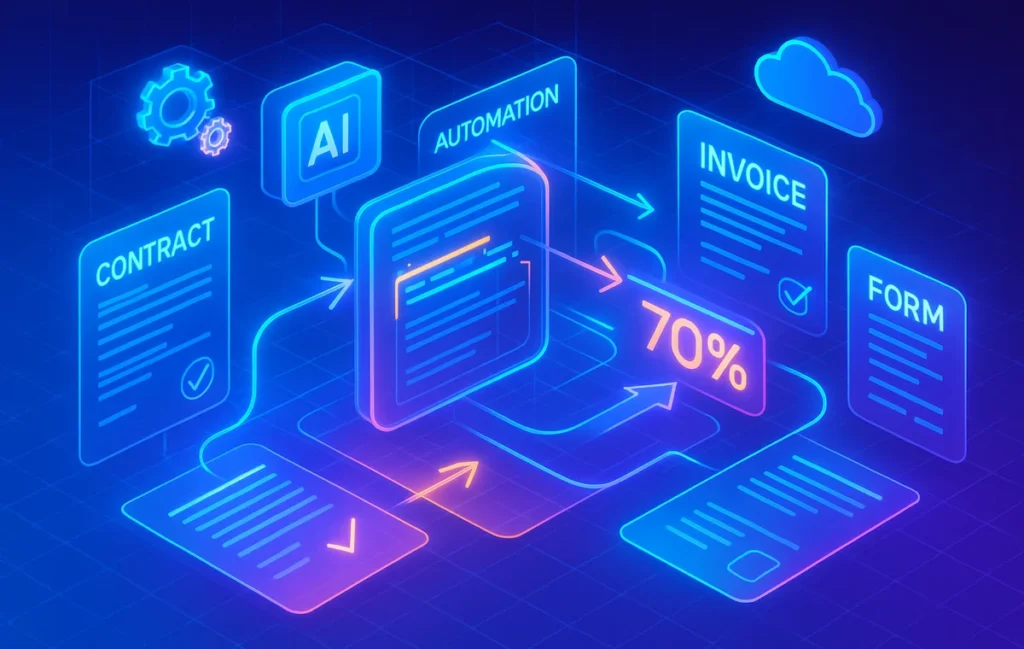📑 Why Document Automation Matters in 2025
For small and medium businesses, freelancers, and remote teams, documents remain the backbone of work. Contracts, invoices, HR forms, and proposals are still everywhere, but managing them manually drains time. A 2024 industry report found that knowledge workers spend up to 11 hours a week preparing, sending, and chasing documents. That’s almost three months of the year lost to repetitive tasks.
This is where document automation software enters the picture. Modern tools promise not just convenience but a reduction of up to 70% in manual work—turning hours of editing, emailing, and follow-ups into minutes. From auto-filling contracts to tracking signatures in real time, these platforms free teams to focus on value rather than admin.
💡 Nerd Tip: Document automation is workflow automation in disguise. If you’ve read our Workflow Automation 101, think of documents as one of the most obvious—but often overlooked—workflows to streamline.
✍️ Key Use Cases: From Contracts to HR Docs
The power of document automation lies in how many types of business files it touches. For sales teams, it means proposals generated automatically with client data already filled in. For HR, it’s employment contracts and onboarding forms triggered the moment a candidate is hired. For finance, invoices are auto-generated and sent with reminders built in.
Imagine a scenario where a contract is drafted in PandaDoc, signed in DocuSign, archived in Google Drive, and synced to your CRM—all without human intervention. Or a marketing agency using Formstack Documents to generate branded proposals in bulk, saving hours every week.
💡 Nerd Tip: Start with your highest-volume document. Automating a single repetitive workflow, like client proposals, often unlocks more value than trying to automate everything at once.
🔧 Leading Tools in Document Automation
Several platforms stand out in 2025, each targeting different priorities.
PandaDoc remains a favorite among SMBs for its polished templates and integrations. Sales teams in particular love its ability to merge CRM data into proposals instantly.
DocuSign is the enterprise giant. Beyond e-signatures, its workflow engine now supports conditional logic—making multi-party agreements smoother and legally watertight.
Formstack Documents is a hidden gem for no-code fans. It plugs into form builders and databases, transforming raw inputs into formatted PDFs, Word docs, or emails automatically.
airSlate positions itself as the all-in-one automation suite, combining document generation with robotic process automation (RPA) for end-to-end workflows.
Xodo Sign offers lightweight, cost-effective signing features for solopreneurs and smaller teams, making it a solid entry point into automation.
💡 Nerd Tip: Don’t confuse document automation with simple e-signature apps. True automation integrates with your CRM, HR, or accounting stack to move data across systems seamlessly.
📊 The 70% Metric: Why It Resonates
Vendors often boast about time saved, but the “70% reduction in manual work” isn’t hype—it reflects measurable wins. A mid-sized marketing agency using PandaDoc reported that their proposal preparation time dropped from 40 minutes to under 10. An HR department using airSlate cut contract onboarding steps from 12 clicks to just 3.
Benchmarks show that across industries, automation tools:
-
Reduce average document preparation time by two-thirds.
-
Increase accuracy by eliminating manual data entry.
-
Shorten sales cycles by 20–30% thanks to faster proposals.
💡 Nerd Tip: Numbers impress leadership. Track how many minutes per document you save and multiply it across your team to prove ROI.
🔄 Integration With Broader Workflows
Document automation doesn’t live in a silo—it thrives when embedded into existing automation stacks. Tools like PandaDoc and Formstack sync natively with CRMs and workflow builders. Pairing them with the apps from Best Workflow Automation Tools for Solopreneurs means you can automate from lead capture through signed contract.
Even browser-based shortcuts matter. As we explained in Save Time with Browser Automation, sometimes the quickest wins come from automating how documents are uploaded, named, or shared online. Document automation is part of this bigger productivity story.
💡 Nerd Tip: Start thinking in chains, not apps. One automation is helpful; three linked automations change the way you work.
🆚 Comparing the Leaders
Here’s a high-level comparison of the top tools:
| Tool | Best For | Strengths | Limitations | Pricing Tier |
|---|---|---|---|---|
| PandaDoc | SMB Sales Teams | Polished proposals, CRM integrations | Higher cost per seat | Mid-High |
| DocuSign | Enterprise Compliance | Legal-grade workflows, global trust | Can feel heavyweight | High |
| Formstack Docs | No-Code Builders | Flexible, form-driven generation | Less advanced e-signing | Mid |
| airSlate | End-to-End Automation | Combines RPA + document workflows | Complexity to master | Mid-High |
| Xodo Sign | Solopreneurs & Small Teams | Affordable, lightweight | Limited enterprise scale | Low |
💡 Nerd Tip: Match tool to context. Don’t overpay for enterprise compliance if all you need is faster invoices.
⚡ Ready to Build Smarter Workflows?
Explore document automation platforms that integrate with your CRM and accounting stack. Slash repetitive work and free your team for strategy.
🧪 Case Study: SMB Gains Back Hours Every Week
A mid-sized SaaS startup with a lean team of 25 employees faced a bottleneck: every client contract and invoice had to be drafted, checked, and sent manually. This consumed nearly three hours of admin time per employee each week. After deploying PandaDoc integrated with their CRM, contracts were generated automatically the moment a deal was marked “Closed Won.” Invoices followed instantly through airSlate.
The result? Average contract preparation time dropped from 30 minutes to under 8 minutes, and invoicing that previously took 90 minutes weekly now happens in under 20. Over a month, the company gained back nearly 200 work hours, allowing sales and finance staff to focus on revenue-driving tasks instead of formatting paperwork.
💡 Nerd Tip: Track hours saved, not just documents automated. Leadership responds better to productivity metrics than feature lists.
💵 ROI and Cost Analysis
The economics of document automation go beyond time saved. Every hour of manual document handling carries hidden costs—lost opportunities, slower deal cycles, and employee fatigue. For SMBs paying $25–$40/hour for administrative support, shaving even two hours per week per person can translate into thousands of dollars annually.
There’s also the reduction in errors: a single misfiled contract or incorrect invoice can cost more than an annual subscription to a tool like DocuSign. Document automation ensures consistency, enforces compliance, and speeds up cash flow by getting invoices out the door faster.
💡 Nerd Tip: Frame document automation as a cost-avoidance strategy, not just a productivity gain. Executives invest faster when they see risk reduction quantified.
📊 Benchmarks That Differentiate Platforms
When comparing leading tools, benchmarks tell the story:
-
Contract Generation Speed: PandaDoc averages 6–8 minutes for a templated contract vs. 25 minutes in manual workflows.
-
Completion Rates: DocuSign documents reach 94% completion within 48 hours, compared to industry averages of 76%.
-
Error Reduction: Formstack Documents users report a 60% drop in manual data-entry mistakes, especially in HR and finance docs.
-
Workflow Depth: airSlate handles multi-step automations spanning 5–7 systems without external middleware, cutting orchestration time in half.
These figures highlight not just functionality but impact—the difference between “a faster e-signature” and “a fully automated lifecycle.”
💡 Nerd Tip: Always compare tools by outcomes (time saved, completion rate) rather than surface features.
🔄 Integration Landscape
Document automation shines brightest when plugged into broader ecosystems. PandaDoc and DocuSign sync seamlessly with CRMs like Salesforce and HubSpot, making them natural allies for sales teams. Formstack connects with Google Workspace, Airtable, and project management tools, giving no-code builders flexibility. airSlate goes further, embedding into HR platforms like BambooHR and financial suites like QuickBooks.
For marketers, integrations matter even more. Pairing document workflows with campaign tools from our Top 10 Automation Tools for Marketers ensures proposals, contracts, and invoices flow directly from leads captured. Combine this with connectors like Zapier vs. Power Automate vs. IFTTT, and suddenly your entire stack feels cohesive.
💡 Nerd Tip: Think of integrations not as “add-ons” but as bridges—each one reduces manual copy-paste between systems.
🔮 Beyond 2025: The Future of Document Automation
Looking forward, document automation is poised to evolve beyond today’s templates and e-signatures. AI copilots are emerging that won’t just generate documents but advise on legal phrasing, tone, and compliance risks. Imagine drafting a contract and receiving AI suggestions on clauses that might shorten negotiations.
Blockchain is also entering the picture. Some vendors are experimenting with blockchain-backed e-signatures that create tamper-proof records for sensitive contracts. Meanwhile, Web3 promises smart contracts that execute automatically once conditions are met—rent agreements that release payments as soon as maintenance logs confirm tasks are done, for example.
The next five years will likely see document automation transition from being a time-saving tool into a strategic compliance and revenue engine. Businesses that adopt early will not only cut manual work—they’ll also shape how agreements are created, verified, and enforced in a digital-first economy.
💡 Nerd Tip: Don’t just buy for today’s use case—choose platforms with AI and blockchain roadmaps to future-proof your investment.
📬 Want More Smart AI Tips Like This?
Join our free newsletter and get weekly insights on automation tools, no-code apps, and future-proof workflows—delivered straight to your inbox.
🔐 100% privacy. No noise. Just value-packed productivity tips from NerdChips.
🧠 Nerd Verdict
Document automation in 2025 is no longer optional—it’s the hidden engine behind efficient teams. PandaDoc and DocuSign dominate for enterprises and sales-driven companies, while Formstack and airSlate empower smaller teams to punch above their weight. Xodo Sign shows that even solopreneurs can embrace automation without overspending. NerdChips’ take? If you’re serious about saving time, document automation should be your first stop before chasing broader stacks like Zapier vs. Power Automate vs. IFTTT or the Top 10 Automation Tools for Marketers.
❓ FAQ: Nerds Ask, We Answer
💬 Would You Bite?
If you could eliminate 70% of your manual document work this year, which workflow would you automate first—contracts, invoices, or HR files?
Crafted by NerdChips for teams who believe their time is worth more than manual paperwork.



